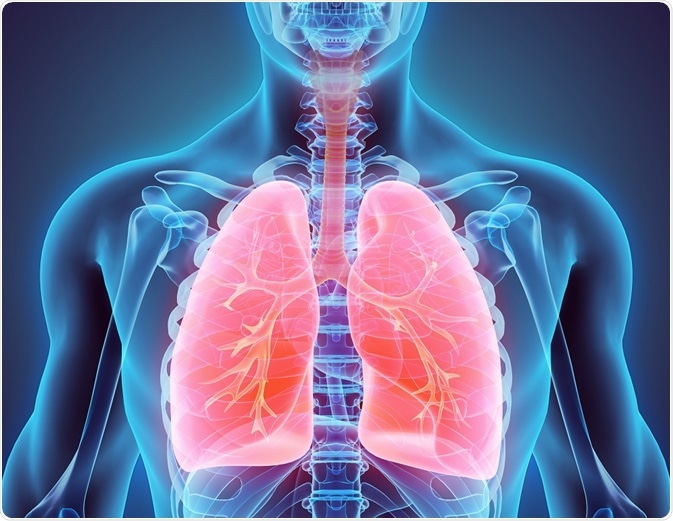Chronic obstructive pulmonary disease (COPD) is a group of syndromes which depict common general symptoms, but differ in several more detailed aspects.

Image Credit: MDGRPHCS / Shutterstock
It is characterized by airway obstruction, difficulty in breathing, chest tightness, and wheezing. Major causes of COPD are tobacco smoking, environmental pollutants, toxic chemicals and fumes, and microbial infections.
COPD is among the leading causes of death globally. The quality of life of a COPD patient drastically reduces due to poor disease prognosis. Increased economic burden due to frequent emergency care visits and hospitalizations increase the challenge.
Phenotypes of COPD
Similar to other pulmonary conditions, lung function tests such as forced vital capacity (FVC) and force expiration volume in 1 second (FEV1) are the primary tools for diagnosing COPD; however, these tests do not provide a bigger picture of the phenotypic characteristics of a particular COPD subtype.
Understanding COPD phenotyping brings medical professionals and health researchers one step closer to managing the disease more effectively. As an effect, targeted and tailored treatment approaches could then be devised to cure COPD, reduce mortality, or at the very least, improve the prognosis of the disease.
Scientists and researchers utilize various approaches in classifying COPD genotypes, including physiologic phenotypes, radiologic phenotypes, and clinical phenotypes.
Physiologic phenotypes
Certain individuals are more prone to COPD. By studying patterns of physiologic parameters, it might be possible to deduce specific factors that play a role in determining COPD type. These factors include body mass index (BMI), sex, age, lung function, responsiveness to bronchodilators, and comorbidities.
Radiologic phenotypes
With technological advancements, it is now possible to observe changes within pulmonary structures at microscopic levels. Computed tomography scans may reveal characteristics such as airway wall thickening and poor diffusing capacity.
These observations may be helpful in treating patients prophylactically before waiting for visible symptoms to appear. Additionally, knowledge of exact anomalies could help in deciding on treatments targeted at the specific areas.
Clinical phenotypes
The most important categorization of COPD phenotyping is based on clinical features of the disease. Accordingly, the classifications are as follows:
Frequent exacerbator
Acute episodes of breathlessness, dyspnea, and coughing are termed as exacerbations. Acute exacerbations are associated with an increased rate of disease progression and poor quality of life. β‑agonists and long-acting anticholinergic medications are useful in treating frequent exacerbators.
Overlap syndrome
Even though separate pathophysiologic mechanisms govern the prognosis of different respiratory conditions such as COPD and asthma, it may sometimes pose a challenge to accurately diagnose the condition due to overlapping symptoms.
This is particularly common in the case of chronic smokers where it is difficult to conclude whether the condition is asthma or smoking-induced COPD. For such patients, inhaled corticosteroids are recommended alongside bronchodilators.
Comorbid syndrome
Sometimes, multiple pulmonary conditions may coexist. Note that in the overlap syndrome, the symptoms are confusing but there is a singular condition; however, in the comorbid syndrome, multiple conditions simultaneously exist.
Emotional frailty
These are patients who display psychiatric symptoms due to COPD. These conditions include depression, anxiety, and fear of COPD exacerbation. This perceived fear translates into increased cost of medical care in such patients. These patients may benefit from early phenotyping and enrollment into pulmonary rehabilitation centers for prophylaxis.
Physical frailty
This condition is associated with the depletion of cognitive and physiologic reserves of the body’s natural mechanisms. Physical frailty is mainly associated with aging. Proactive identification of frailty and participation in outpatient rehabilitation programs could significantly improve the quality of life of these patients.
Emphysema subtype
An anatomical category predominantly involving the upper lobe had been empirically identified as an important phenotype. Patients under this subtype have been found to benefit from surgical lung volume reduction procedure.
Rapid decliner type
This type recognizes a group of COPD patients who, without any apparent reason, exhibit quick worsening of lung function. Such patients are usually of young age and do not possess other cardiac comorbidities. The mortality rate within this COPD phenotype is alarming; however, the underlying pathophysiology of rapid decliner subtype is still unknown.
Understanding COPD
Further Reading
Last Updated: Aug 23, 2018